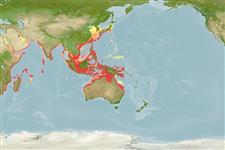Common names from other countries
>
Carangiformes (Jacks) >
Carangidae (Jacks and pompanos) > Caranginae
Etymology: Parastromateus: Greek, para in the side of + Greek, stromatos = a fish flattened body with a lot of colours (Stromateus sp.) (Ref. 45335).
More on author: Bloch.
Environment: milieu / climate zone / depth range / distribution range
Ecologie
marien; brak water rifbewoner; amfidroom (Ref. 51243); diepte 15 - 105 m (Ref. 12260), usually 15 - 40 m (Ref. 54702). Tropical; 42°N - 30°S, 32°E - 154°E
Indo-West Pacific: East Africa to southern Japan and Australia.
Lengte bij maturiteit / Grootte / Gewicht / Leeftijd
Maturity: Lm 23.0, range 22 - 24 cm
Max length : 75.0 cm TL mannelijk / geslacht onbekend; (Ref. 5284); common length : 30.0 cm TL mannelijk / geslacht onbekend; (Ref. 3287)
Dorsale stekels (totaal) : 2 - 6; Dorsale zachte stralen (totaal) : 41 - 46; Anale stekels: 2; Anale zachte stralen: 35 - 40; Wervels: 24. Deep-bodied and strongly compressed fishes. Lateral line ends in weakly-developed scutes on the caudal peduncle. Pelvic fins lost in individuals over 9 cm. Color is brown above, silvery-white below. The anterior parts of the dorsal and anal fins bluish-gray. The other fins yellowish.
Adults inhabit coastal areas with muddy substrate. Found near the bottom during daytime and near the surface at night. They also enter estuaries (Ref. 1479). Normally form large schools (Ref. 5213). Swim on its side near the surface (Ref. 3197). Feed on zooplankton (Ref. 30573). Excellent food fish (Ref. 3197); marketed fresh, may be dried or salted (Ref. 5284).
Paxton, J.R., D.F. Hoese, G.R. Allen and J.E. Hanley, 1989. Pisces. Petromyzontidae to Carangidae. Zoological Catalogue of Australia, Vol. 7. Australian Government Publishing Service, Canberra, 665 p. (Ref. 7300)
Status op de Rode Lijst van het IUCN (Ref. 130435)
CITES (Ref. 128078)
Not Evaluated
Gevaar voor de mens
Harmless
Gebruik door de mens
Can't connect to MySQL database (fbapp). Errorcode: Too many connections
